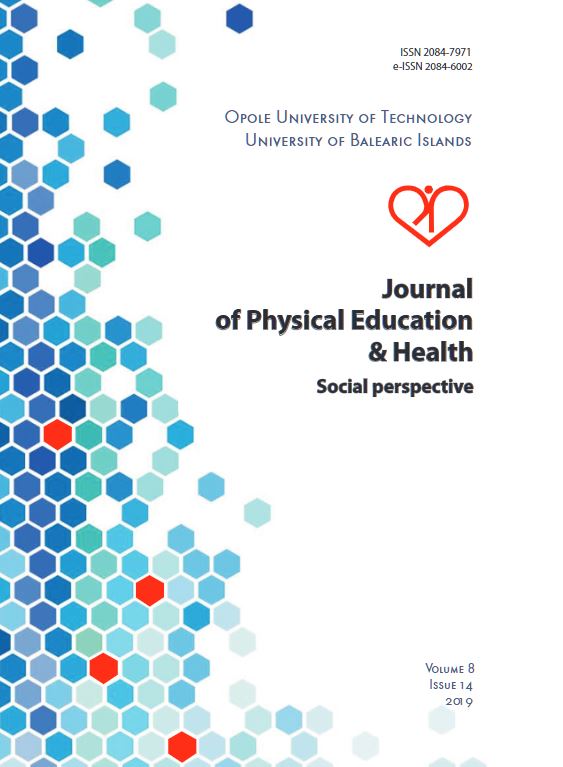Abstract
We have investigated the relationship between performance in sports exercises and perceived difficulties in
physical ability tasks for boys and girls. In order to assess physical abilities in sport, we conducted experiments
concerning methods for self-evaluating the difficulty of physical ability required in sports exercises through
implementation of creative vaulting tasks in addition to Eurofit and Evareg tests. Based on a hypothesis that
specific physical abilities could predict performance in physical education for boys and girls, we distinguished
the relationship between genders concerning perceived difficulty for varied ability tasks. Although sporting
exercises performance was high among boys rather than girls, there was no significant difference in perceived
difficulties of physical tasks between genders. We highlight how perceived difficulties among students appears to
have resulted in higher student motivation levels, and increased desire to improve performance for more effective
learning and teaching experience. We recommend that methods of perceiving difficulties in sport exercises need
more exploration for better practices
References
Davisse A. Les mixités en EPS. Revue EPS 1986; 197: 56‒57.
Derbali C., Matoussi F., Elloumi A. Teaching Strategies to Enhance Motor Skills Learning for Groups of Students: The Effects of Verbal and Visual Feedback on Performance in Pole Vault Practice. Journal of Physical Education & Health 2018c; 8(13): 1‒10.
Derbali C., Matoussi F., Elloumi A. Motivational Climate and Skills Development in Physical Education: A Pilot Study Examining Physical Activity Behavior in an Educational Environment. Journal of Information Research and Review 2017c; 4(12): 4756‒4763.
Derbali C., Matoussi F., Elloumi A. Physical Activity, Body Culture and Safety of Learning: A Systematic Review in Physical Education. International Journal of Innovative Studies in Sociology and Humanities 2019a; 4(7): 14‒21.
Radwan H., Hasan H. A., Ismat H., Hakim H., Khalid H., Al-Fityani L., Mohammed R., Ayman A. Body Mass Index Perception, Body Image Dissatisfaction and Their Relations with Weight-Related Behaviors among University Students. International Journal of Environmental Research and Public Health 2019; 16: 1541.
Delignières D. La perception de la difficulté dans les tâches motrices. Thèse d’Habilitation à Diriger les Recherches, France: Université Montpellier, 1996.
Durand M. L’enfant et le sport. Paris: PUF, 1987.
Delignières D., Famose J. P. Estimation des exigences bioénergétiques des tâches motrices. Influence de l'âge et du sexe. STAPS 1991; 12(24): 63‒72.
Eurofit. Eurofit Tests of Physical Fitness, 2nd Edition. Strasbourg: Sports Division Strasbourg, Council of Europe Publishing and Documentation Service, 1993.
Franks B. D. YMCA youth fitness test manual. Champaign, IL: Human Kinetics Publishers, 1989.
Derbali C., Matoussi F., Elloumi A. Curriculum Method Grounded on Didactic Engineering to Expertise Physical Education Program Proposal. Journal of Education and Practice 2018b; 9(31): 49‒59.
Skarveli E., Zervos I. Official report of the XXVIII Olympiad. Athens: Organising Committee for the Olympic Games, 2005.
Chaponnière M. La mixité scolaire: débats d'hier et d'aujourd'hui. In : Dafflon Novelle A. (ed.) Filles-garçons: socialisation différenciée, PUG, 2006, pp.127‒144.
Davisse A. Louveau C. Sports, école, société. La différence des sexes. Paris: L’Harmattan, 1998.
Grabowski H., Szopa J. Eurofit. European Test of Physical Fitness. Kraków: AWF, 1991.
Ribeiro N. F., Yarnal C. M. The Perceived Difficulty Assessment Questionnaire (PDAQ):
Methodology and applications for leisure educators and practitioners. Schole: A Journal of Leisure Studies and Recreation Education 2010; 25: 111‒115.
Legros P., Rieu M. Physical capacities in men versus women. Science & Sports 1990; 5(4): 203–2013.
Derbali C., Jannet Z., Elloumi A. Physical self-perception and sport’s activity applied in physical education context: The self-efficacy of achievement performance. International Journal of Advanced Sport Sciences Research 2015a; 3(1): 482‒497.
Wrisberg C. A., Pein R. L. Past running experience as a mediator of the attentional focus of male and female recreational runners. Perceptual and Motor Skills 1990; 70: 427‒432.
Baird J. C., Noma E. Fundamentals of scaling and psychophysics. New York: Wiley, 1978.
Thurstone L. L. A law of comparative judgement. Psychological Review 1927; 34: 273‒286.
Derbali C., Elloumi A., Matoussi F. Reflections and Conceptions Analysis of the Neosphere’s Actors on Teaching Pole Vault Activity throw Physical Education Program. International Research Journal of Curriculum and Pedagogy 2017a; 3(2): 52‒58.
Ryan R. M., Deci E. L. Brick by brick: The origins, development, and future of self-determination theory. In: Elliot A. J. (ed.) Advances In motivation science. Cambridge, MA: Elsevier Inc., 2019; 6: 111‒156.
Fontayne P. Motivation et activités physiques et sportives : influence du sexe et du genre sur la pratique du sport et de l’éducation physique. Thèse de doctorat: sciences biologiques fondamentales et appliquées: psychologie. France, Université Paris, 1999.
Derbali C., Elloumi A., Matoussi F. Didactics of Physical Education: The Case of Motivational students Profiles in Pole Vaulting Performance. Creative Education 2015b; 6 (12): 1349‒1359.

This work is licensed under a Creative Commons Attribution-ShareAlike 4.0 International License.
Copyright (c) 2019 Array

